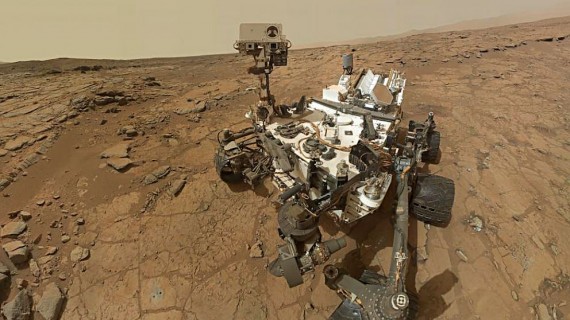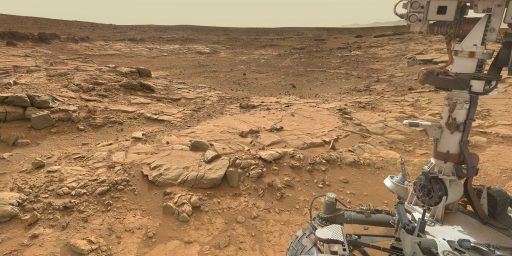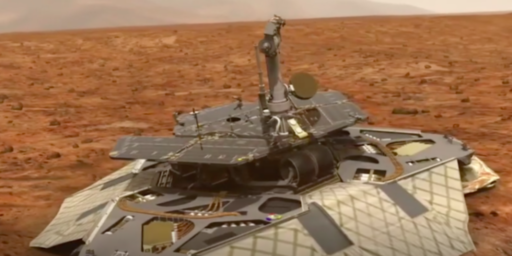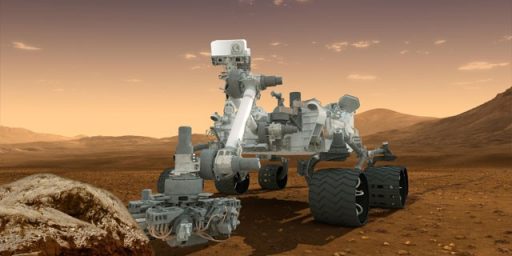Curiosity Finds Water In The Soil Of Mars
Mars may appear to be dry and barren on the surface, the Curiosity rover has found evidence of water in the Martian surface:
Future Mars explorers may be able to get all the water they need out of the red dirt beneath their boots, a new study suggests.
NASA’s Mars rover Curiosity has found that surface soil on the Red Planet contains about 2 percent water by weight. That means astronaut pioneers could extract roughly 2 pints (1 liter) of water out of every cubic foot (0.03 cubic meters) of Martian dirt they dig up, said study lead author Laurie Leshin, of Rensselaer Polytechnic Institute in Troy, N.Y.
“For me, that was a big ‘wow’ moment,” Leshin told SPACE.com. “I was really happy when we saw that there’s easily accessible water here in the dirt beneath your feet. And it’s probably true anywhere you go on Mars.”
(…)
Using its Sample Analysis at Mars instrument, or SAM, Curiosity heated this dirt to a temperature of 1,535 degrees Fahrenheit (835 degrees Celsius), and then identified the gases that boiled off. SAM saw significant amounts of carbon dioxide, oxygen and sulfur compounds — and lots of water on Mars.
SAM also determined that the soil water is rich in deuterium, a “heavy” isotope of hydrogen that contains one neutron and one proton (as opposed to “normal” hydrogen atoms, which have no neutrons). The water in Mars’ thin air sports a similar deuterium ratio, Leshin said.
“That tells us that the dirt is acting like a bit of a sponge and absorbing water from the atmosphere,” she said.
While the presence of water in Martian soil is potentially good news for a long term space mission since astronauts could theoretically extract water from that soil, other studies uncovered factors that may make such a mission more complicated:
SAM detected some organic compounds in the Rocknest sample as well — carbon-containing chemicals that are the building blocks of life here on Earth. But as mission scientists reported late last year, these are simple, chlorinated organics that likely have nothing to do with Martian life. [The Hunt for Martian Life: A Photo Timeline]
Instead, Leshin said, they were probably produced when organics that hitched a ride from Earth reacted with chlorine atoms released by a toxic chemical in the sample called perchlorate.
Perchlorate is known to exist in Martian dirt; NASA’s Phoenix lander spotted it near the planet’s north pole in 2008. Curiosity has now found evidence of it near the equator, suggesting that the chemical is common across the planet. (Indeed, observations by a variety of robotic Mars explorers indicate that Red Planet dirt is likely similar from place to place, distributed in a global layer across the surface, Leshin said.)
The presence of perchlorate is a challenge that architects of future manned Mars missions will have to overcome, Leshin said.
“Perchlorate is not good for people. We have to figure out, if humans are going to come into contact with the soil, how to deal with that,” she said.
“That’s the reason we send robotic explorers before we send humans — to try to really understand both the opportunities and the good stuff, and the challenges we need to work through,” Leshin added.
A challenge, no doubt, but also yet another testament to just how productive Curiosity has been barely just over a year into its mission on Mars. It will be fascinating to see what else it has in store for us.






The entire idea of a station on Mars much less colonization is absurd. Mars has no magnetic field to block cosmic or solar radiation. A human trip to Mars might as well be a one way trip because the humans won’t live long enough once they return to earth to make the return trip worthwhile.
@Ron Beasley:
Are these guys your cousins or do you all meet once a month at the Pessimist Club?
http://groups.yahoo.com/neo/groups/pessimist_club/info
The same can be said of the moon missions. (or Mercury, or Gemini, as well as those of the Soviet space program) The risks were enormous, and they were taken with 1960s technology. But we stepped up and got the job done.
Should we focus on reality TV and naval gazing because space travel is difficult and dangerous? Or should we get back to the business of creating the future?
To quote James Kirk – “Risk, gentlemen, is our business”
@anjin-san: Quotes from fictional characters are just fine.
Sometimes quotes from real speechwriters can be at least as good.